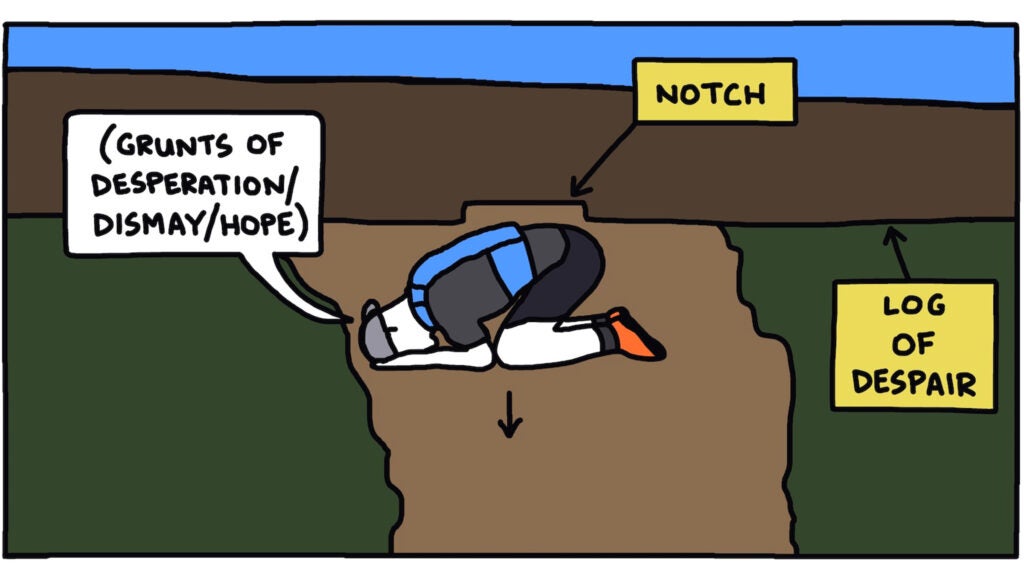No products in the cart.
Outdoor Adventure
The Ultra-Trail Cape Town 100K Is Not for the Faint of Heart
For a half-second, I thought the naked man crutching toward me on the trail was a hallucination. But the 44 kilometer mark was way too early in the race for me to have been hallucinating. As I moved to the right side of the double track to give him some room, I noticed a crucifix hanging from a silver chain around his neck, so, correction: not completely naked.
I kept running, out of the woods and back onto the sand of the beach, following the race flags. A dozen or so beachgoers were spread out across the football field-length of sand, mostly in groups of two, no one covering themselves with much fabric, if any at all, and none of them paying attention to a sweaty man in a running vest shuffling across the sand with a pair of trekking poles.
Here is an illustration of several eggplants at an ocean beach.
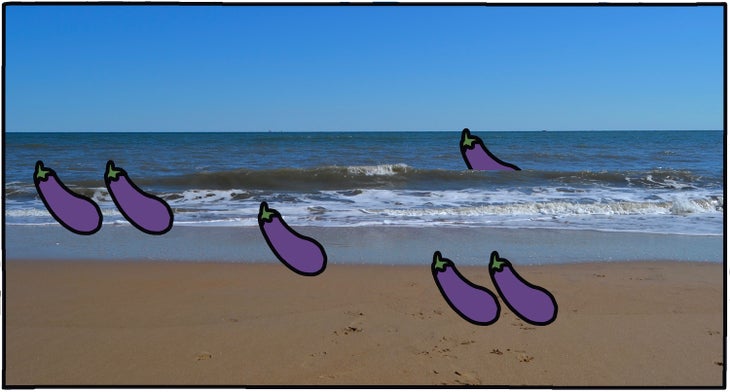
The nude beach, while notable, was not the biggest surprise of the Ultra-Trail Cape Town 100K. The biggest surprise, by sheer volume, was how much I underestimated the race course.
Mike and I had been drinking coffee at a bakery on October 5th, 2023 when I asked him, “What do you have going on the rest of the year?” and he said he was considering a race in South Africa around Thanksgiving, but was probably not going to go. But maybe if I wanted to go he would go, but probably not. I said I would ask Hilary what she thought, and when I did, she all but told me I had to go. So 36 days before the race, I signed up for the 100K, which promised over 16,300 feet of elevation gain in just over 62 miles of technical trails on and around Table Mountain, which sounds fun when you gloss over the numbers and adjectives.
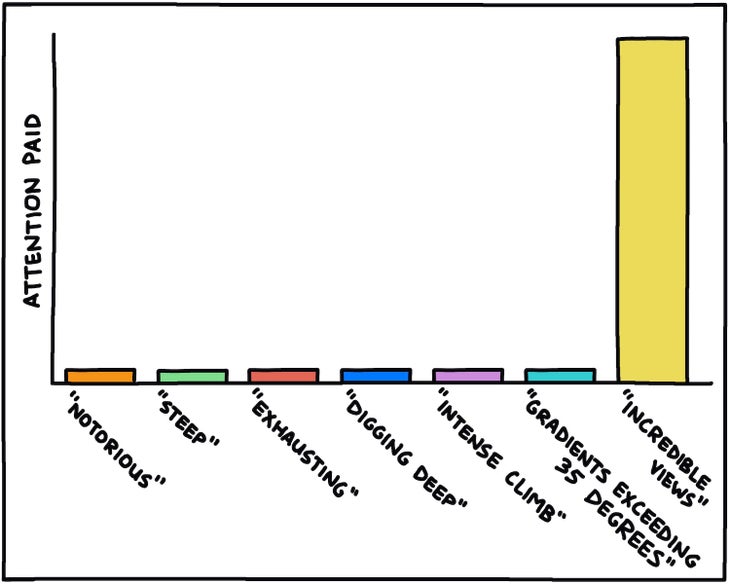
We flew from Montana to Cape Town, a 30-hour travel day, and Mike woke up with a cold the next morning. I still had four nights of sleep before my race, plenty of time to adjust to jet lag but also plenty of time to catch a cold from your friend sleeping in the adjacent hotel bed. Mike ran the 55K the day before my 100K race and was in bad shape the entire race. I somehow managed to not catch his cold, but slept poorly three nights in a row and finally took a Unisom the night before the 100K and logged almost nine consecutive hours of sleep only interrupted by the power going out and coming back on, which happens every night during load shedding, which has been adopted by the South African government due to an ongoing energy crisis.
At 5:55 A.M., I squeezed into the humming mass of 266 runners in the starting corral, carrying my collapsed poles in my left hand and starting my watch as we crossed over the timing mat under the arch. We ran on streets for three kilometers and then hit doubletrack and singletrack, climbing up toward the peak of Lion’s Head.
Around eight kilometers, the trail started to wind around the west side of Lion’s Head, and I started to see why Mike had described the course as “Half New Hampshire, half Moab,” after his race the previous day: It wasn’t totally made up of loose, fist-sized rocks, but there were enough of them that I had to pay attention to every step, or I would OUCH! roll an ankle or slam the inside of my foot onto a rock. It was very heads-up running, certainly not what my American feet might call “buff singletrack.”
I smashed my feet awkwardly a couple times as we wound around Lions Head, but thought, “Maybe this is just a particularly technical section and the rest of the route is more chill?” Spoiler: It was not more chill. It was not chill at all.
Like a fool, I rolled into the first aid station at Kloof Nek at 20.1 kilometers and didn’t immediately chug a liter of water in preparation for a nearly 3,300-foot climb up the northeast face of Table Mountain via Platteklip Gorge. I also, like a fool, picked up a peanut butter sandwich that turned out to be not peanut butter at all, but Marmite. I am not going to shit on Marmite, but it’s definitely a surprise when your mouth is expecting the smooth taste of Skippy or Jif. I walked back to the aid station table and grabbed a peanut butter sandwich for a palate cleanser. It was also Marmite.
It was fall turning into early winter when I left Montana, and in the southern hemisphere, where South Africa is located, it was spring turning to summer. Plus, Cape Town is next to the ocean, and can be quite humid. The humidity was legitimate, which I knew from hanging out around the race course the day before, and I would need to work hard to stay hydrated.
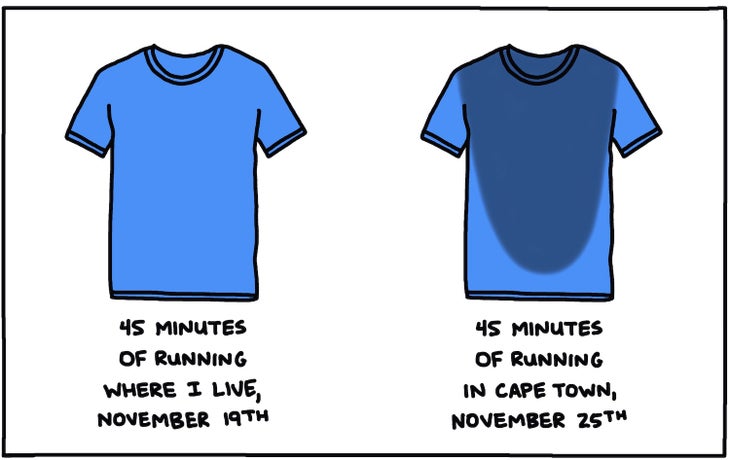
Of course I didn’t work hard at it, and by 25 kilometers I ran out of water. I was about two-thirds of the way up Platteklip Gorge, a switchbacking path of approximately 1.5 million 12- to 18-inch high rock steps in full sun, with no breeze, but plenty of Saturday hikers, a very gregarious man singing “My Bonny Lies Over the Ocean” near the top. The reward for the climb is a) a view from the top of Table Mountain b) a nice breeze and c) you get to stop climbing and just run across the top of Table Mountain for a while.
I tried to hustle, wanting to make up for the very time-intensive miles I’d just clocked on my way up the mountain, but the twists and turns and technicality of the trail kept my pace in check. As I ran down a set of rock steps, I noticed someone had broken off the bottom eight inches or so of a trekking pole in a fissure in a rock. That’s a bummer, I thought, wondering if it was someone in the race today.
The trail continued to wind and roll over the top of Table Mountain to the 31.1 kilometer aid station, where I chugged a liter of water and a cup of Coca-Cola before filling all three of my bottles and moving on. I ran, I hiked, I hucked myself forward on my poles, I full-on hands-and-feet scrambled, I squeezed through chimneys in fluted sandstone, and then found myself descending a short fixed rope on a vertical bit of rock. A fixed rope!
This was not the first time during this race that I said to myself, “Trail running, LOL,” and also not the last time during this race.

It was around 38 kilometers that I started to realize that this course was probably not going to let up, and I might as well settle into the reality that I was going to have a slow day. After the fixed line, I carefully picked my way down steep and exposed switchbacks, lowered myself down a couple short rock faces on via ferrata-style staples, and jogged short bits between. As I descended, the temperature rose, the breeze was stifled, and by the time I got onto the surfers’ path between the fancy houses in the suburb of Llandudno, I was pouring sweat again. It was getting close to 1:30 P.M., inching toward the hottest part of the day. At the aid station, I slugged down two 17-ounce bottles of water, one with a packet of LMNT, and then refilled my bottles before heading out to run across the beach, then the nude beach, then a boulder field, then another beach, before another steep climb in full sun.
On the climb up to Rocket Road, I caught up to a couple guys, one of whom was stopping to sit down on the rock steps every couple minutes. We were in full sun in the humid air just above the ocean, and I felt maybe 10 percent better than that guy did, but kept hucking myself upward on my poles.
I was aware that elite runners had shown up in Cape Town a week or more in advance of the race, which I assume is something elite runners do so they can ensure they’re as prepared as possible to compete at their best. We had shown up a few days early, but only made time for one short run, during which we saw about 100 meters of trail that was on the actual race course. The rest of the days before my race, I spent trying to iron out jet lag so I could sleep at night and having anxiety about catching Mike’s cold. In retrospect, a little reconnoitering of some trails would have helped establish some expectations.
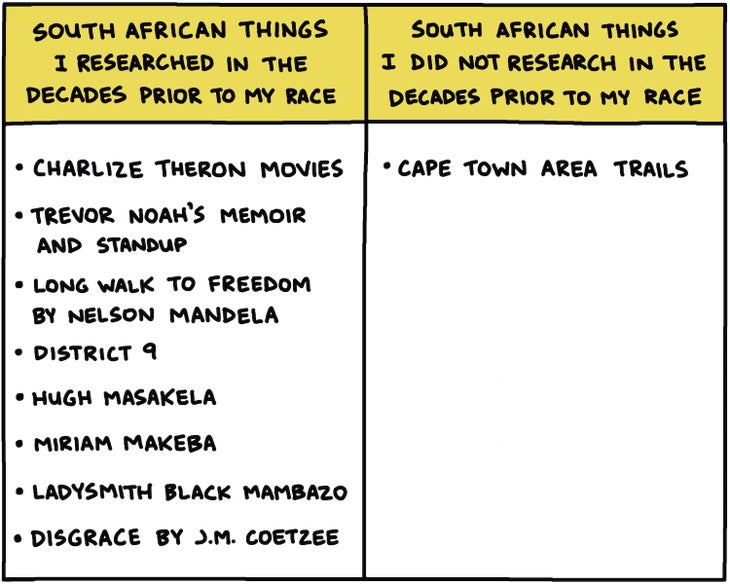
Instead, I just kept telling myself things like, “Surely the second half won’t be as tough,” and “I bet this is the last tough climb.” This was the closest I could get to positive self-talk. Because every time the course flattened out for a few minutes, around the next corner was a big middle finger of a trail or a climb. Which can be demoralizing, but then again, I would remind myself, did you sign up for a challenge, or a day of lying in a hammock and eating pineapple?
At about 48 kilometers, the route took a hard right up the northeast ridge of Suther Peak, which was allegedly nicknamed “Suffer Peak.” Thankfully, we had a nice breeze. Here’s a photo of the course’s elevation profile, which is nice if you want a *general idea* of statistics:
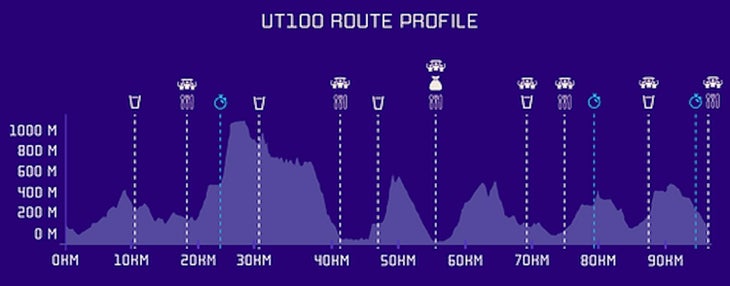
Okay sure, it’s steep, right. What is not visible on the elevation profile are the actual details of the steep parts, which, on Suther Peak, look like this:
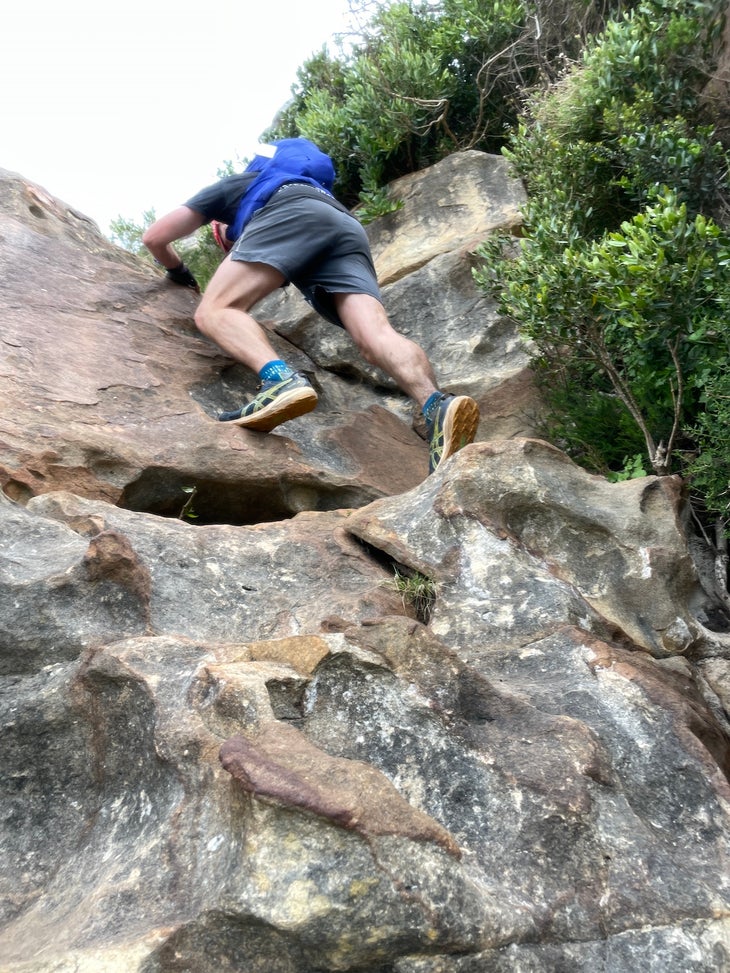
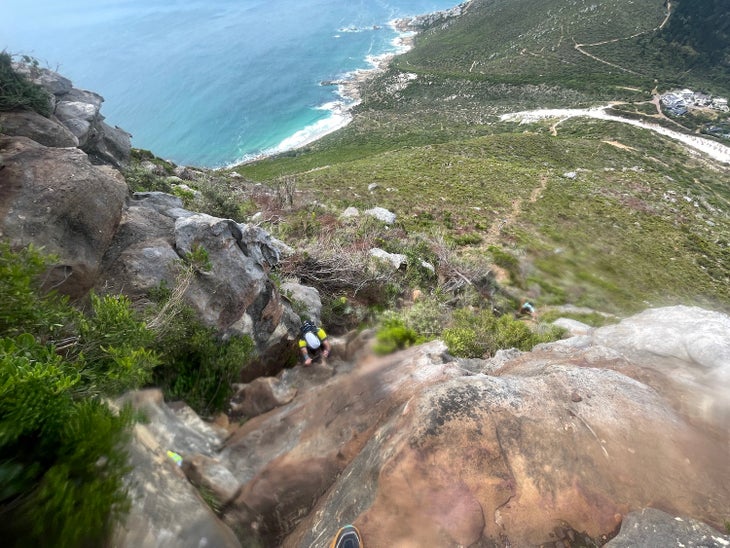
The day before, I had ridden around with Lance Wynne, owner of Runcation South Africa, and he had said that people get in trouble on the UTCT course when they started worrying about how slow they might be going relative to their expected pace for a 100K race. I thought of this piece of advice every time I looked down at my watch and noticed I had just clocked another 29-minute mile and started to feel the big sad coming on.
Thankfully, the descent of Suther Peak had maybe the longest stretch of runnable trail on the race course: sandy singletrack and a jeep track that was fairly free of loose rock. I coasted down and into Hout Bay, running down the street in front of the wharf, where I saw a couple with ice cream cones and thought about buying one, and then a little girl carrying one of the flags used to mark the race route. Then I was on the beach again, pounding sand, thinking about joining kids playing soccer and football, then scanning for the Hout Bay aid station, then plunging my feet into a stream on the beach, soaking both feet and filling my shoes with beach sand. I looked up to see Mike waiting for me on the beach a few meters before at the aid station, and said I guess I’d need those spare shoes in my drop bag after all.
We jogged into the aid station, where I switched out my socks and shoes over the course of what felt like 20 minutes as Mike tried to look away from a gentleman using both hands to lube his entire undercarriage just behind me. Looking for a spot to set my water bottles, I turned to the table behind my chair and glanced at a pair of trekking poles, one of which was missing its bottom eight or so inches—the match for the broken-off pole tip I’d seen while crossing Table Mountain 30 kilometers ago, which felt like two years ago at this point.
While I was in the aid station with 41 kilometers left in my race, refilling water bottles and replenishing my running food, the winner, Dmitry Mityaev, crossed the finish line in a superhuman 10 hours and 43 minutes. This had almost zero relevance to my personal race, except that we were following the same route. American Anthony Costales, who finished 41 minutes after Mityaev and took third place, later wrote on Instagram: “Race day, I was in for a surprise as I learned a new meaning of what technical trails look like. I went into this race prepared and excited, but surprised by how few sections of “flow” existed. At 40 kilometers I knew I was going to be in for a long day that probably wouldn’t be my best performance but maybe showcased some versatility.” OK, so it wasn’t just me.
I finally dragged myself out of the aid station, saying goodbye to Mike and smashing peanut butter sandwiches and cookies into my face as I walked up the road. When I’d finally swallowed all the food I’d taken from the aid station, I started to jog, slowly, telling myself that even though it was uphill, the flat sidewalk was “easy money” compared to whatever probably lay ahead. The route climbed nearly 1500 feet in the next five kilometers, but eventually emerged on a stunning trail contouring across the southwest face of a peak. I passed a couple runners and did my best to run the runnable sections, watching the sun inch closer to the horizon over the bay. There are certainly worse places to get your ass kicked.
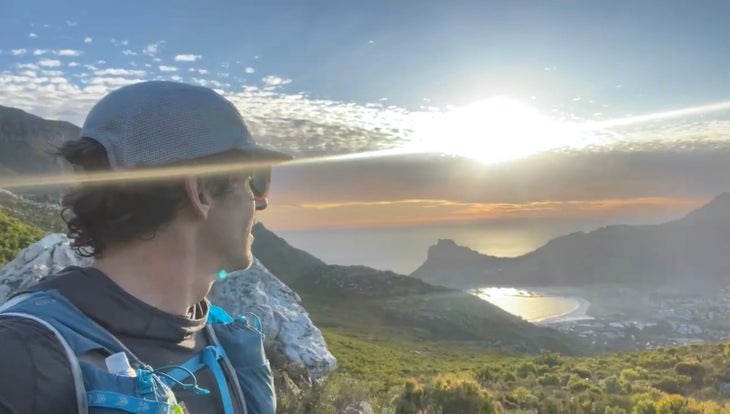
I contoured around the northern slopes of the mountain, not sure where the trail went, and I couldn’t see any other runners anywhere I scanned. Race flags kept popping up every few hundred meters, so I was okay. We were just spread out at this point. Mike had told me at the Hout Bay aid station that I had been gradually moving up in the race throughout the day. I didn’t know it at the time, but 77 runners had dropped from the race by Hout Bay, which was at 56.5 kilometers, with 41 kilometers to go. A total of 103 runners (out of 266) would drop before the end of the race, which I think is a good indicator that it was harder than a lot of people anticipated.
As the sun set, and then the last light faded, I entered the vineyards near Constantia Nek. I finally dug out a headlamp and clicked it on after running between rows of grapes, thinking it would be really dumb to get this far and miss a race marker because I didn’t have a headlamp on (despite carrying two headlamps in my vest all day, as required). I ran into the Alphen Trail aid station, just over 20 kilometers from the finish, to what felt like a ridiculous amount of cheering and applause for the 106th place runner in a race, but you know what, that’s what makes ultramarathons great. What made this one even better is the reception the guy behind me got from the 20-plus friends of his who went absolutely apeshit when he came into the tent, an outpouring of support so joyous that I think some of it spilled over on me as I clicked my headlamp back on and shuffled back onto the trail.
From here on, the final 20 kilometers had two 1300-foot climbs. If you were, say, a visitor looking at a map of Cape Town area trails, trying to figure out the flattest route from where I was to the finish line, you would choose a different route. But who wants that? I mean, the little crybaby man inside me did at the time. I slogged onward, running as much as I could, using my poles to huck myself forth every two steps or so.
At some point, as I shuffled heroically through the darkness, the trail was blocked by a giant fucking tree that had fallen and gotten stuck exactly parallel to the ground and perpendicular to the trail. Someone had sawed out a chunk of the bottom of the tree, just high enough for a very creaky runner to perform a sort of prostration in the dirt or momentary prayer to the gods of ultramarathon race course design or whoever, Please Allow Me To Get Back Up From This Without My Entire Body Cramping All At Once, I Beseech You.
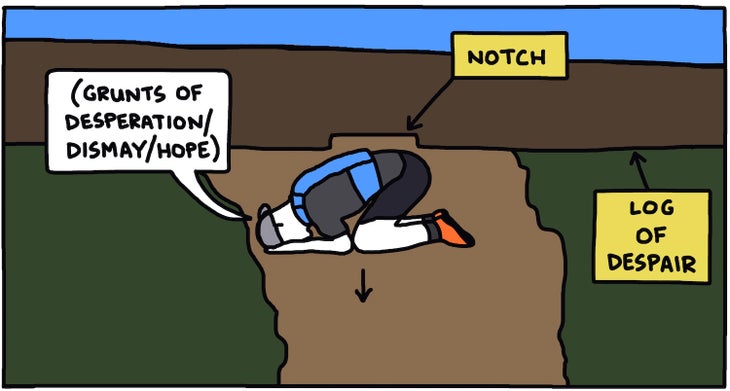
I slowly lowered myself onto my hands and knees, slid sideways, brushing my vest on the underside of the tree, inhaled cautiously, and unfolded myself into a standing position, expecting to crumple onto the ground in pain and lie there until sunrise. But nothing happened. I started running again, no doubt looking like Eliud Kipchoge, if Kipchoge were 90 years old and running a 15-minute mile using trekking poles.
The trail climbed, flattened out, climbed again, and wound in and out of gullies, parts of it runnable, parts of it less runnable by someone like myself in my current state, and I just kept chugging along, stopping once to urinate, a proud moment after an entire day of sweating literal liters of fluid and hours of being on the verge of catastrophic muscle cramps. I patted myself on the back, and made a mental note to create a Certificate of Achievement of Absolute Minimum Self-Care During A Race for my office wall when I got home.
Suddenly there were three headlamps behind me, approaching fast. They caught me, and I let them pass, only to have them let me pass a couple minutes later. We leapfrogged a couple times before I realized it was the guy who had gotten the ovation at the last aid station, and two friends who were pacing him. They were running in spurts, taking a break every few minutes, then charging again. We arrived at the campus of the University of Cape Town at about the same time, and I jogged into the aid station a minute or two ahead of them. And again, the guy got a huge ovation. I filled my water bottles, grabbed some snacks, and headed out for the last climb, to the King’s Blockhouse, which I had heard was steep and unrelenting. It was, and I was glad I had poles for it, because it suuuuucked, but it would have sucked twice as much if I had to do it without poles.
I had joked to Mike back at 56.5 kilometers that my goal was to “finish in the top 300,” but I had no idea where I was or how many people had dropped. For the final 10 kilometers after the Blockhouse, I just wanted to hang on and not get passed by 20 people. Looking ahead on the trail for headlamps, I scanned the north face of Table Mountain high above the city lights. To my dismay, the three or four headlamps in front of me kept going higher, and higher, meaning I still had to keep going up.
Finally, they started going downhill, which might have been a relief, but my legs and general morale were so hammered that it took everything I had to motivate to run 15-minute miles on the way down the loose rock on the singletrack and jeep roads. I brainstormed tag lines for the UTCT in my head:

Finally, I popped out on a quiet city street, empty except for two race staffers making sure we didn’t get lost with a half kilometer to go. I turned left, then another left at some signs saying WELCOME HOME, and then into the rugby club, past the race expo tents, and through the finish arch, where maybe 20 people were still hanging out, including Mike. It was a few minutes before 2:00 A.M., 19 hours and 48 minutes after I’d started. I had definitely gotten my money’s worth.
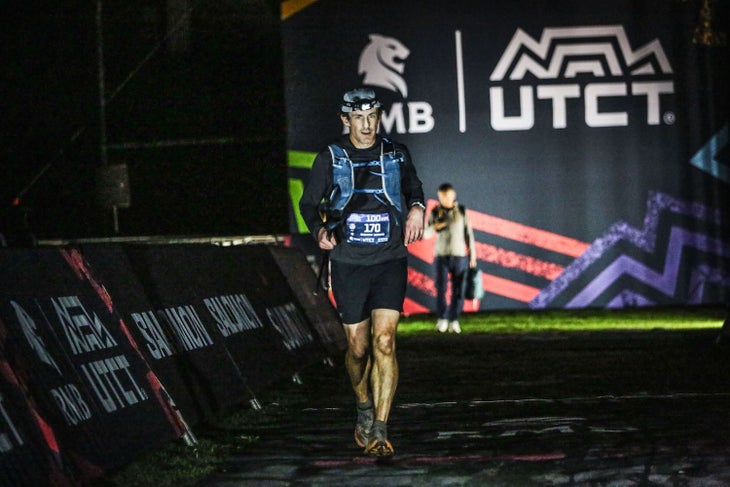
Source link

